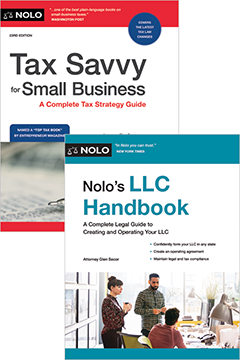Get basic information on how to pay federal income tax for your unincorporated single-member LLC.
By default, the IRS will treat a single-member limited liability company (SMLLC) as what it calls a disregarded entity. This means that the IRS will not look at an SMLLC as an entity separate from its single owner for the purpose of filing tax returns. Instead, just as it would do with a sole proprietorship, the IRS will disregard the SMLLC, and the owner will pay taxes for the business as part of his or her own personal tax returns. (Because responsibility for paying income tax on an SMLLC classified as a disregarded entity passes through the SMLLC to the owner personally, this way of taxing SMLLC profits is called pass-through taxation.)
Paying Federal Income Tax
To report and pay federal income tax on your SMLLC's business, you will need to attach Schedule C, Profit or Loss From Business, to the personal federal tax return you file with the IRS. Schedule C contains information about your SMLLC's annual income, expenses, and overall profit or loss. To complete Schedule C, you'll need to have good records of all of the income and expenses associated with your SMLLC. This means you'll need to track bank deposits and keep receipts and records of your SMLLC's business transactions throughout the year. In addition, if you have a home office, you should keep track of any relevant home expenses, and complete Form 8829,Expenses for Business Use of Your Home, that shows how you calculated your home office deduction.
You attach Schedule C, along with any other required Schedules or forms, to your IRS Form 1040, U.S. Individual Income Tax Return. The net profit (or loss) that you show on Schedule C is included as part of the total income (or loss) that you report on your personal Form 1040.
EXAMPLE: Marcy has an SMLLC for her part-time, home-based landscape design business. Last year she earned a total of $30,000 from the business and had expenses totaling $5,000 for new equipment, supplies, and other items. She also earned $50,000 in salary from her part-time job as an employee with an architectural firm. Marcy uses Schedule C to show her earnings and expenses from her landscape design business. She attaches the Schedule C to her personal Form 1040, where she reports and pays taxes on her combined net income of $75,000 ($25,000 from her landscape design business and $50,000 from her architectural job).
You Must Pay Tax on All Profit (Whether You Distribute It or Not)
As a disregarded entity, if your SMLLC has a net profit for a given year, you're required to pay taxes on that profit, regardless of whether or not you actually distribute that profit to yourself. The IRS doesn't distinguish between cases where an owner of a SMLLC leaves the profits in the business's bank account and those where the owner withdraws the money. Instead, for tax purposes, the IRS assumes all profits are distributed to the SMLLC owner. The IRS takes this approach because it doesn't want SMLLC owners to take different amounts of money out of the business each year in order to lower their annual taxes.
EXAMPLE: Ryan's SMLLC, which manufactures and sells motorcycle accessories, earned $120,000 this year after expenses. Ryan knows he'll need $60,000 next year to buy new equipment and inventory. However, even if he leaves $60,000 in his company account to use next year for business-related purposes, he will have to report and pay tax on the full $120,000.
Note: You'll pay income tax very differently if you choose to classify your SMLLC as a corporation with the IRS. There are separate articles on this topic elsewhere on the Nolo website. If you want additional general information on taxes your SMLLC may need to pay, check out the other tax-related articles in the SMLLC section of Nolo's website. And for more in-depth information, you can always go to irs.gov.



